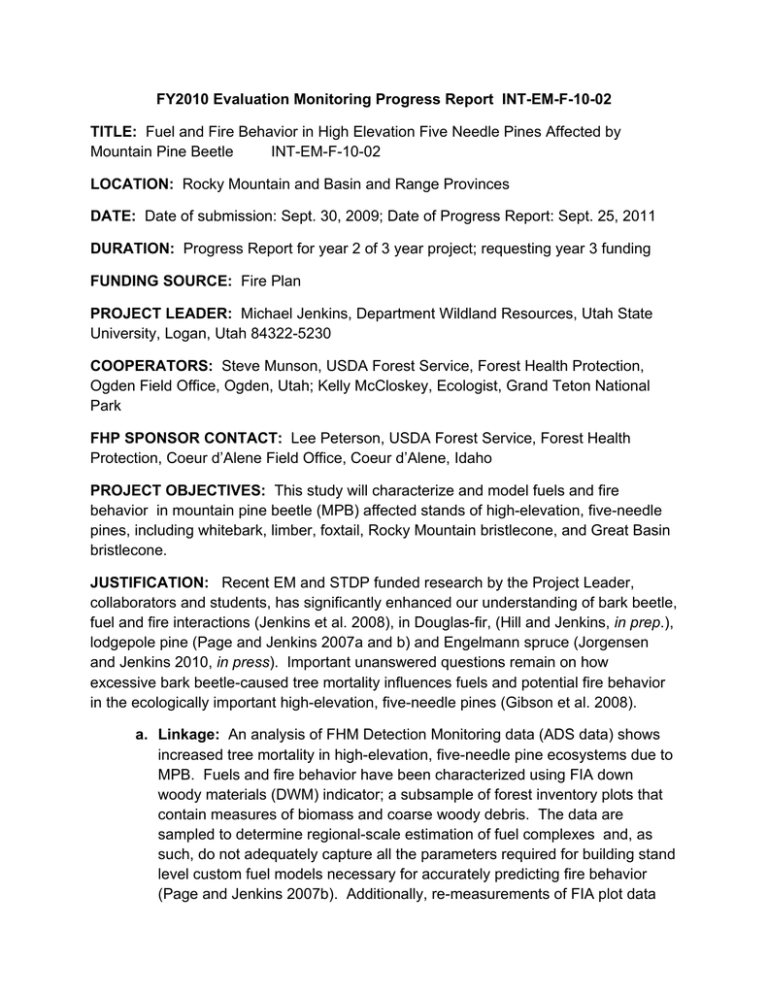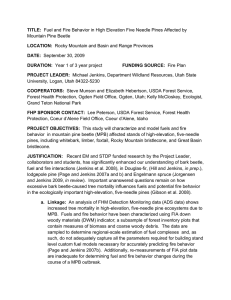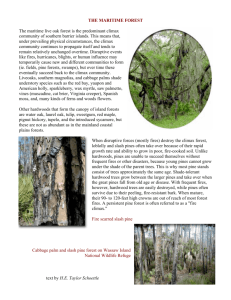FY2010 Evaluation Monitoring Progress Report INT-EM-F-10-02 TITLE: LOCATION: DATE:
advertisement

FY2010 Evaluation Monitoring Progress Report INT-EM-F-10-02 TITLE: Fuel and Fire Behavior in High Elevation Five Needle Pines Affected by Mountain Pine Beetle INT-EM-F-10-02 LOCATION: Rocky Mountain and Basin and Range Provinces DATE: Date of submission: Sept. 30, 2009; Date of Progress Report: Sept. 25, 2011 DURATION: Progress Report for year 2 of 3 year project; requesting year 3 funding FUNDING SOURCE: Fire Plan PROJECT LEADER: Michael Jenkins, Department Wildland Resources, Utah State University, Logan, Utah 84322-5230 COOPERATORS: Steve Munson, USDA Forest Service, Forest Health Protection, Ogden Field Office, Ogden, Utah; Kelly McCloskey, Ecologist, Grand Teton National Park FHP SPONSOR CONTACT: Lee Peterson, USDA Forest Service, Forest Health Protection, Coeur d’Alene Field Office, Coeur d’Alene, Idaho PROJECT OBJECTIVES: This study will characterize and model fuels and fire behavior in mountain pine beetle (MPB) affected stands of high-elevation, five-needle pines, including whitebark, limber, foxtail, Rocky Mountain bristlecone, and Great Basin bristlecone. JUSTIFICATION: Recent EM and STDP funded research by the Project Leader, collaborators and students, has significantly enhanced our understanding of bark beetle, fuel and fire interactions (Jenkins et al. 2008), in Douglas-fir, (Hill and Jenkins, in prep.), lodgepole pine (Page and Jenkins 2007a and b) and Engelmann spruce (Jorgensen and Jenkins 2010, in press). Important unanswered questions remain on how excessive bark beetle-caused tree mortality influences fuels and potential fire behavior in the ecologically important high-elevation, five-needle pines (Gibson et al. 2008). a. Linkage: An analysis of FHM Detection Monitoring data (ADS data) shows increased tree mortality in high-elevation, five-needle pine ecosystems due to MPB. Fuels and fire behavior have been characterized using FIA down woody materials (DWM) indicator; a subsample of forest inventory plots that contain measures of biomass and coarse woody debris. The data are sampled to determine regional-scale estimation of fuel complexes and, as such, do not adequately capture all the parameters required for building stand level custom fuel models necessary for accurately predicting fire behavior (Page and Jenkins 2007b). Additionally, re-measurements of FIA plot data are inadequate for determining fuel and fire behavior changes during the course of a MPB outbreak. b. Significance: High-elevation, five-needle pines are rapidly declining throughout western North America due to warming temperatures, invasive species, especially white pine blister rust, and reduction of naturally occurring fires. However, MPB is regarded as the most serious short-term threat (Gibson et al. 2008). We propose to investigate MPB, fuel and fire relationships over a large regional scale of ecosystems containing highelevation, five-needle pine species. c. Biological Impact: The loss of high-elevation, five-needle pines due to a combination of white pine blister, MPB, increasing temperatures and altered fire regimes can detrimentally impact valuable resources including food for wildlife, watershed and soil protection, and aesthetics and recreation. d. Scientific Basis/Feasibility: It is very likely the project will be successfully completed because the methods and data analysis were thoroughly developed during previous work in other conifer/bark beetle/fuel/fire systems. e. Priority Issues: This project will address fire risk and fuel loading, ecological impacts of fires in sensitive and valuable ecosystems and invasive species (white pine blister rust). DESCRIPTION: a. Background: MPB has been caused extensive mortality of high-elevation, five-needle pines across western North America since 1998 (Gibson et al. 2008). Information is lacking on MPB, fuel and fire interactions in highelevation, five-needle pine ecosystems. The work proposed here is especially relevant since white pine blister rust causes additional tree mortality and predisposes infected trees to MPB attacks. MPB attacks larger diameter trees while white pine blister rust kills smaller diameter trees. This damage may result in changes to ladder fuels when compared to MPB infested stands alone. . b. Methods: Specific stands within the general study areas will be selected by identifying locations with endemic and outbreak MPB populations. Fuels data will be collected using the methods adapted for bark beetle fuels interactions by Page and Jenkins (2007a). c. Products: This work will result in the production peer reviewed manuscripts; oral presentations; graduation of a MS student. d. Schedule of Activities: 2010: plot location a data collection, 2011: data collection, 2012: data analysis and manuscript preparation. Progress/Accomplishments 2011: The study objectives were narrowed to focus fuels beneath individual whitebark pines. Study sites were selected using ADS maps, Forest Service personnel and GIS. Sites were located in Wyoming on Deadline Ridge near LaBarge on the southeastern edge of the Bridger-Teton National Forest. One hundred fifty seven plots were sampled in the area in three different stands. Plots were placed at five chain intervals along transects from a randomly selected GPS starting coordinate. A total of 465 trees were measured. Plots consisted of measuring individual trees of three different stages of whitebark; green (healthy), red (approximately 2 years since infestation) and gray (approximately 3 years since infestation). Height, height to crown, diameter at breast height, and crown width were measured on each tree to obtain crown size. Surface fuel load, litter and duff depths were measured half way from the bole to the drip line at four cardinal directions beneath each tree. On the south side of each tree 1hr and 10hr fuels were counted along a 2 meter transect. Vegetation percentages were taken in a plot frame on the north side of each tree. On every fifth plot litter was collected from a 0.3 x0.3 meter square and returned to the lab to oven dry and weigh for bulk density calculations. Beneath every tenth red tree a small sample of litter was collected and mailed to Justin Runyon from the Rocky Mountain Research Station in Bozeman, MT to analyze terpenes in the litter. A permanent plot of green, yellow (1yr since attack), red, and gray trees were selected for fuel moisture content samples. Samples were collected from each tree condition class at two week intervals. Field weight was determined in the field then samples were returned to the USU lab to oven dry and determine dry weight. Fuel moisture content has been determined for each sample at each sampling interval. COSTS: Each year for FY 2010-2012 FHM EM Administration Procurements Item EM Funding Other Source Funding Salary 24,000 15,000 Overhead 3,600 2,595 Travel 3,500 Source USU, FHP Contracting Equipment 500 Supplies 500 1,000 32,100 18,595 Year Totals We are presently requesting year 3 of 3 year funding. LITERATURE CITED: Gibson, K, K Skov, S Kegley, C Jorgensen, S Smith and J Witcosky. 2008. Mountain impacts in high elevation five needle pines: current trends and challenges. USDA FS, FHP, R1-08-020, 32 pp. Jenkins, M.J. (in press) Fuel and fire behavior in high-elevation five-needle pines affected by mountain pine beetle. In Keane, R.E. (ed.), Proc. The future of highelevation five-needle white pines in western North America, Gen. Tech. Rep. RMRS-xx, USDA Forest Service. Rocky Mountain Research Station, Missoula, MT. Jenkins, MJ, EG Hebertson, WG Page, and CA Jorgensen. 2008. Bark beetles, fuels, fires and implications for forest management in the Intermountain West. Forest Ecology and Management 254(2008): 16-34. Jorgensen, CA and MJ Jenkins. Spruce beetle induced changes to selected Engelmann spruce fuel complexes within the Intermountain region. Forest Science (In press). Jorgensen, CA and MJ Jenkins. Predicted fire behavior in selected spruce beetle infested Engelmann spruce stands. Forest Science (In review). Page WG and MJ Jenkins. 2007a. Mountain pine beetle induced changes to selected lodgepole pine fuel complexes within the Intermountain Region. Forest Science 53(4): 507-518. Page WG and MJ Jenkins. 2007b. Predicted fire behavior in selected mountain pine beetle infested lodgepole pine stands Forest Science 53(6): 662-674.


